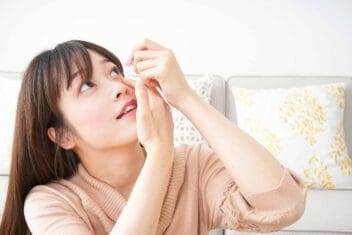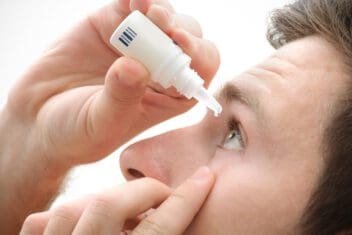Dry Eye Prescription & Over-the-Counter Medications
Home / Dry Eyes: Causes, Symptoms & Treatments /
Last Updated:
Dry eyes are common, and there are many underlying causes of this condition. If you are frequently irritated by dry eye symptoms, you may wonder if over-the-counter eye drops or prescription eye drops may work better for you. There are several well-known over-the-counter eye drop brands, but five stand out.
It is possible that over-the-counter drops are not enough, or you find yourself applying them frequently, so some prescription dry eye treatments might work better.
The best approach to treating dry eye depends on your specific circumstances. Discuss the situation with your eye doctor.
Dry Eye Treatments: Finding the Best Symptom Relief

Dry eye is a common vision problem that can be irritating, but in severe scenarios, it can lead to eye damage.
This condition occurs when your eyes cannot stay wet. This might be because you do not produce enough tears, your tears are poor quality, or you have tear ducts that absorb the fluid too quickly. You could also live in a dry environment, struggle with chronic allergies, or take prescription medications that change the quality of your tears. You may also wear your contact lenses too long, causing your eyes to dry out.
You deserve clear vision. We can help.
With 135+ locations and over 2.5 million procedures performed, our board-certified eye surgeons deliver results you can trust. Your journey to better vision starts here.
If you have chronic dry eye, your eyes may be red or pink from irritation; you may feel like something is in your eye all the time; your eyes may feel itchy; or you do not get a lot of moisture when you blink and your eyelids could feel sticky. You may also struggle with blurry vision, stinging or burning sensations, and sensitivity to light.
Eye drops are the most common solution to dry eye. If you have mild dry eye, you may already use over-the-counter eye drops to keep your eyes in good shape. If you have a more serious form of dry eye, you may need to work with your optometrist to get prescription eye drops.
Over-the-Counter Dry Eye Drops
Over-the-counter eye drops come in two basic varieties: with preservatives and without. Eye drops that have preservatives contain chemicals that discourage bacterial growth once the bottle has been opened. Those without preservatives may have a shorter shelf-life or come in single-dose bottles.
In general, if you have mild dry eye or do not apply artificial tears more than once or twice a day, getting eye drops with preservatives is fine. If you have moderate or severe dry eye and apply eye drops four or more times per day, most eye doctors agree that you should get artificial tears without preservatives.
These are the top five most recommended over-the-counter brands of eye drops:
- GenTeal Lubricant Eye Gel: More than just artificial tears, this gel is designed for people with severe dry eye symptoms. It works well for people who have mild or moderate dry eye too. The gel remains on the eye for longer, improving your tear film.
- Systane Ultra Lubricant Eye Drops: This brand of eye drops is well known for relieving red eye, itchiness, and irritation from dry eyes. The drops also improve your tear film quality, so your eyes remain moist for longer.
- Visine All Day Comfort Dry Eye Relief: Visine is a popular brand for all forms of eye care products, including contact lens solutions and eye drops. This specific type of eye drop is formulated to help people with intense, irritating dry eye symptoms, ranging from mild to severe.
- Bausch + Lomb Lumify Redness Reliever Eye Drops: Another brand that is known for its effective eyecare products, Bausch + Lomb provides redness relief and eases irritation and itching symptoms. The drops work in one minute and last for eight hours, so you will put drops in your eye much less often than with other brands.
- Refresh Optive Mega-3 Preservative Free Drops: Refresh offers eye drops both with and without preservatives. Their preservative-free brand offers single-use containers to prevent contamination and infection, ensuring the product is sterile. The drops also contain natural ingredients like flaxseed oil, which naturally lubricate your eyes for longer.
Using over-the-counter eye drops is the most common method of managing dry eye symptoms, but pay attention to your eyes’ condition. If you do not get enough relief from over-the-counter options, talk to your optometrist about prescription brands.

You deserve clear vision. We can help.
With 135+ locations and over 2.5 million procedures performed, our board-certified eye surgeons deliver results you can trust. Your journey to better vision starts here.
Prescription Dry Eye Treatments
If you cannot get good relief from dry eye symptoms by using over-the-counter brands, you can ask your optometrist or ophthalmologist for help getting a good prescription eye drop. These brands may be recommended:
- Lacrisert: From Bausch + Lomb, these prescription drops work slowly, and they continue working throughout the day. While it is prescribed for dry eye symptoms, Lacrisert is not specifically an eye drop. It is an insert that goes under your lower eyelid, where the conjunctiva on the inside of the eyelid meets the conjunctiva of the eyeball. This will slowly liquify over the day, working with your natural tears to keep your eyes moist.
- It is only applied once per day. It is important to apply it as directed because corneal abrasions can result from improper use.
- Restasis: Also known as Allergan, this dry eye treatment should be applied only once per day. On top of reducing redness and keeping your eyes moist, Restasis reduces inflammation in the eye, which helps your eyes to feel less puffy, irritated, or scratchy.
- This option takes about 90 days to fully ease your symptoms. During that time, you may experience some burning sensations in your eyes.
- Xiidra: Like Restasis, Xiidra reduces inflammation in the eye as it alleviates itching, lessens redness, and improves tear quality. These drops take longer to work than Restasis. Some medical studies have shown it can take up to 12 weeks to see results. Studies also show they come with the potential for some side effects, such as altered taste sensation and reduced visual acuity.
Many Approaches to Managing Dry Eyes
Although you will apply prescription dry eye drops less often than over-the-counter medicines, you are more likely to experience side effects from prescription options. If you already take some prescription medications, ask your optometrist or ophthalmologist if there are any interactions with prescription dry eye drops.
Prescription drops will cost more, but they may be covered by your vision insurance. Over-the-counter treatments will not be covered by vision insurance, but they cost less and are easier to access.
Ultimately, how you manage your dry eye symptoms involves a conversation between you and your eye doctor. Talk to them about your symptoms and how they vary over time. They may recommend you start with over-the-counter drops and then progress to prescription eye drops if those prove ineffective.
You deserve clear vision. We can help.
With 135+ locations and over 2.5 million procedures performed, our board-certified eye surgeons deliver results you can trust. Your journey to better vision starts here.
References
- Dry Eye. (July 2019). National Eye Institute (NEI).
- Lubricating Eye Drops. (August 2018). American Academy of Ophthalmology (AAO).
- The Pros and Cons of Preservatives. (April 2015). Review of Ophthalmology.
- GelTeal Tears Lubricant Eye Gel. CVS.
- Systane Ultra Lubricant Eye Drops. Walgreens.
- Visine All Day Comfort Dry Eye Relief. Visine.
- Refresh Optive Mega-3 Preservative Free Drops. Walgreens.
- Homepage. LumifyDrops.
- Lacrisert. Bausch + Lomb.
- Homepage. Restasis.
- Homepage. Xiidra.
This content is for informational purposes only. It may have been reviewed by a licensed physician, but is not intended to serve as a substitute for professional medical advice. Always consult your healthcare provider with any health concerns. For more, read our Privacy Policy and Editorial Policy.